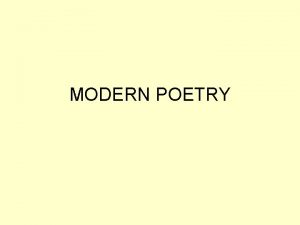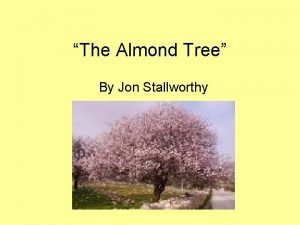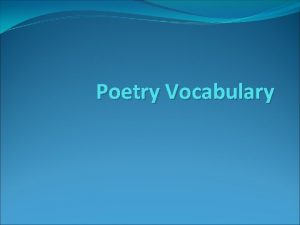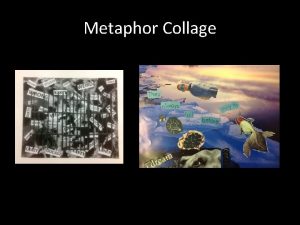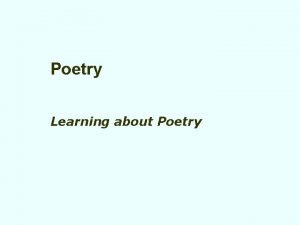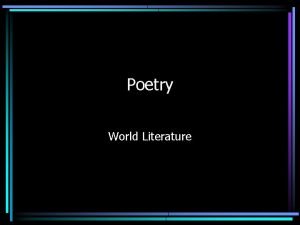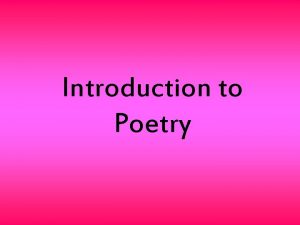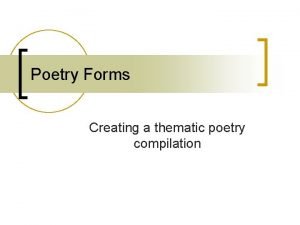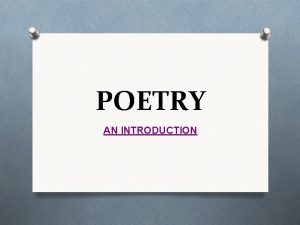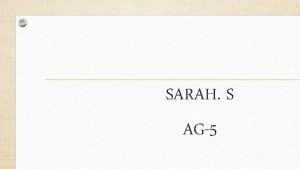Poetry The Importance of One Word MetaphorSimile 1





















- Slides: 21

Poetry The Importance of One Word

Metaphor/Simile 1. Anger is like an acid eating away at your insides. (simile, explicit comparison) Her icy silence froze the conversation. (metaphor, implicit comparison) 2. Many poems revolve around a central metaphor: A is like B.

Simple Steps to Decipher A Poem 1. 2. 3. 4. Identify vocabulary. Research allusions. Paraphrase each line. What poetic devices are used? In this case we have identified central metaphor as the device. Establish WHY these devices were used? What theme is developed by the poet? Diction: the word we use to talk about a poet’s choice of words. Connotation: the suggestive or associative implications of a word. For topic sentence: Tell in one sentence what the poem does.

Writing TS: Robert Frost uses a central metaphor in his poem to compare the passing of the seasons to the passing of life. How do you get from TS to CS? CS: By making this comparison, Frost suggests that the joy of life is brief and should be savored since like all good things, it cannot last.

Internal Structure of Paragraph u u u Topic sentence 1 -2 sentences explaining/expanding on ts Set-up first example Signal phrase + example Analyze the example (paraphrase, identify poetic device, discuss effect of device) Transition to next example Set-up Signal phrase + example Analyze example (paraphrase, identify poet device, discuss effect of device) “so what” (relate to life, universal significance) Concluding sentence

MLA citation of poems u For a poem, cite the line number. When Dickinson uses the word “civility” she invokes the image of a polite gentlemen (8).

MLA citation of poems Enclose quotations of 3 or fewer lines of poetry in quotation marks within your text, and indicate line breaks with a slash. The first time you cite use the words line/s in your citation. The opening lines of Frost’s “Fire and Ice”, strike a conversational tone: “Some say the world will end in fire, / Some say in ice” (lines 1 -2).

MLA citation of poems u For 4 or more lines…. The opening stanza of Louise Bogan’s “Women” startles readers by presenting a negative stereotype of women: Women have no wilderness in them They are provident instead, Content in the tight hot cell of their hearts To eat dusty bread. (1 -4) Bogan seems to suggest that women as a whole are more concerned with the domestic arts than exploring the world.

MLA citation of poems How it appears on work cited page. Collins, Billy. “Introductions to Poetry”. Poetry 180. New York: Random House, 2003.

Works Cited Page Potter 6 Works Cited Collins, Billy. “Introductions to Poetry”. Poetry 180. “ New York: Random House, 2003. Koriyama, Naoshi. “Unfolding Bud”. An Afternoon Together. London: Collier Day, 1995. Noyes, Afred. “The Highwayman”. The Heath Anthology of British Literature. New York: Houghton Mifflan, 1981. ---. “The Lost Woman”. The Works of Noyes Website. 23 Oct. 2004 <http. //www. noyespoems. com>.

More Devices u Central metaphor is a poetic device. There are many other poetic devices. Tone: the emotional, psychological, environmental mood or feeling of the poem. u Examples of words that describe tone: sad, MELANCHOLY, happy, LIVELY, scary, GOTHIC (notice words in CAPS are more precise words, uncapped words should be avoided, too general and vague). u

Tone What is the tone? u How is it established? – Imagery – Connotation – Sound u Are there any shifts in tone? What theme does the tone develop and support?

More definitions u Personification: giving human qualities to nonhuman things u Symbolism: when something concrete represents something that is abstract u Allusion: implicit or explicit reference to something in previous history or literature

Sound Kinds of stress or quality u Meter: recurrence of a rhythmic unit u Stanza: group of lines whose metrical pattern is repeated throughout the poem u Scansion: process of measuring verse u Foot: a metric unit consisting of stressed and unstressed syllable(s).

Basic kinds of Feet/Meter u Iamb/iambic un/st u Trochee/trochaic st/un u Anapest/anapestic un/un/st u Dactyl/dactylic st/un/un u Spondee/spondiac

Sound Kinds of repetition u. End rhyme: when the last words of each line in a poem rhyme u. Alliteration: repetition of beginning sound/letter of word u. Assonance: resemblance of sound in vowels

Sounds Kinds of Repetition u Consonance: resemblance of sound in consonants. u Refrain: repetition of whole phrases, lines or stanzas

Sound Kinds of Quality u Sounds smooth, rough, sharp, blunt, hard, soft u Sound suiting sense. ONOMATOPOEIA

Writing For each body paragraph… TS=State what the poet does with the literary term and its effect on the poem. Body=Explain HOW the poet uses the term and the effect on the poem’s meaning/message. Give examples to support your explanation. CS=Reiterate what the poet does and state WHY the poet did it.

Example William Blake uses alliteration in “The Tyger” to create a sense of a tiger’s movement. The beginning and ending stanza’s of the poem repeat a rhythmic consonant sound in the first lines. The poem begins, “Tyger, burning bright” (line 1). This repetition of the “t” and “b” sound suggests the pacing of the tiger. One almost gets the sense that the animal itself is coming toward us. This same sentence is repeated at the start of the final stanza of the poem, “Tyger, burning bright” (21). This repetition of alliteration instills the reader with a final sense of anticipation, as if the tiger might jump out from the jungle to make himself known. By creating this sense of movement with the technique of alliteration, Blake establishes a sense of danger concerning the tiger. We are not sure whether to thank or question God for creating him. Blake uses alliteration to create a sense of danger in order suggest that man should show awed reverence toward the world’s creator.

TPCASTD T = title P = paraphrase C = connotation A = attitude S = shifts T = tone D = devices
 Metaphor collage
Metaphor collage One empire one god one emperor
One empire one god one emperor One one one little dog run
One one one little dog run One king one law one faith
One king one law one faith One empire one god one emperor
One empire one god one emperor One ford
One ford See one do one teach one
See one do one teach one One price policy
One price policy Willow cabin speech
Willow cabin speech Studiendekanat uni bonn
Studiendekanat uni bonn One vision one identity one community
One vision one identity one community One vision one identity one community
One vision one identity one community Neoclassical poetry vs romantic poetry
Neoclassical poetry vs romantic poetry Traditional poetry vs modern poetry
Traditional poetry vs modern poetry Lyric poetry tells a story
Lyric poetry tells a story Augustan age and romanticism
Augustan age and romanticism Poetry poetry
Poetry poetry Hát kết hợp bộ gõ cơ thể
Hát kết hợp bộ gõ cơ thể Slidetodoc
Slidetodoc Bổ thể
Bổ thể Tỉ lệ cơ thể trẻ em
Tỉ lệ cơ thể trẻ em Voi kéo gỗ như thế nào
Voi kéo gỗ như thế nào













